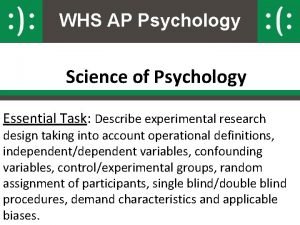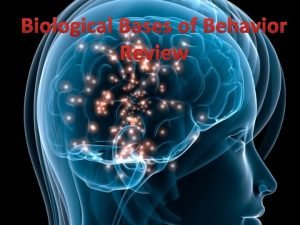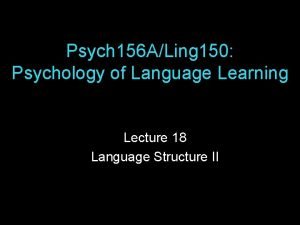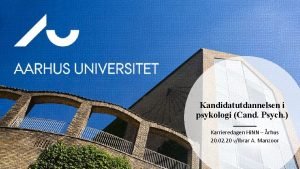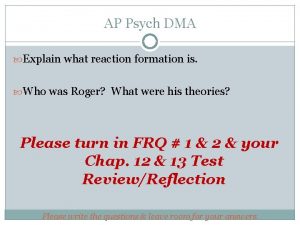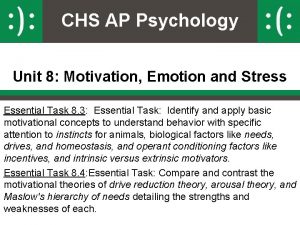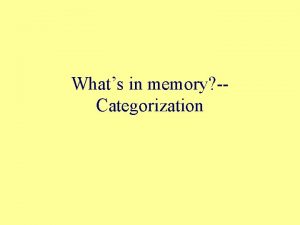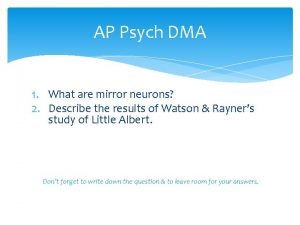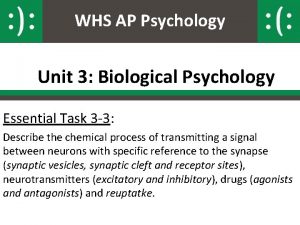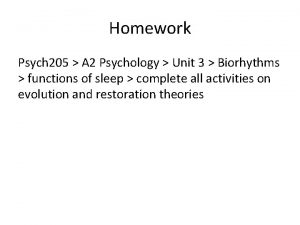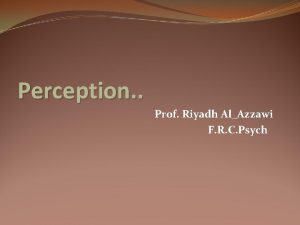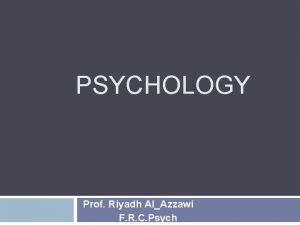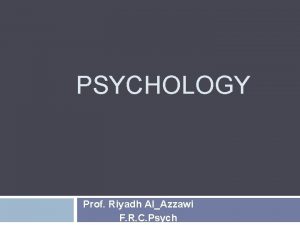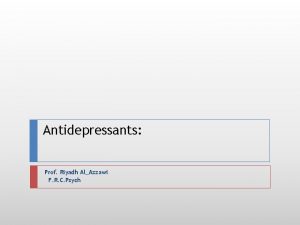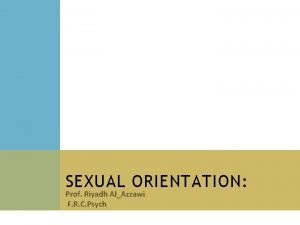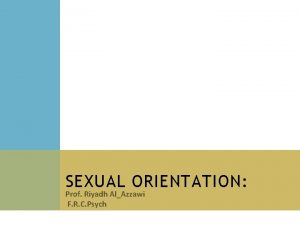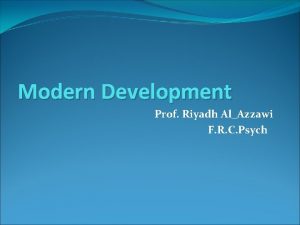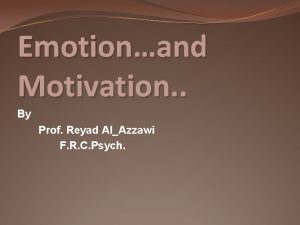Perception Prof Riyadh AlAzzawi F R C Psych

















- Slides: 17

Perception. . Prof. Riyadh Al_Azzawi F. R. C. Psych

Perception: is the study of how we integrate sensory information into percepts of objects and how we then use these percepts to get around in the world (a percept is a product of a perceptual process). It include Recognition and Localization) both are important for survival. Another goal of perception is perceptual constancy. In all processes attention plays a role.

Recognition: Recognizing an object by assigning it to a category as this is a cat ; this is a car and so on and recognizing people by assigning visual input to a particular individual that is Ahmed ; this is Selma; recognition allows us to infer many properties of the object. We use many attribute of the object to recognize it’s shape ; size; color ; texture; orientation all these may contribute but the shape appears to play the most critical role. For example we can recognize a cup regardless of it’s size ; color; texture or orientation we rely on the shape in it’s recognition. One piece of evidence is the recognition of objects from simple line drawings ; which preserve only the shape of the objects.

Localization: To know where the objects in our environment are , the first thing that we have to do is to separate the objects from one another and from the background. So the perceptual system can determine the position of this object , in three dimensional world including their distance from us and their patterns of movement.

Separation of objects: The image projected on our retina is a mosaic of varying brightness and colors. Somehow our perceptual system organizes that mosaic into a set of discrete objects projected against a background. Figure and ground: in a stimulus that contains two or more distinct regions , we see part of it as a figure and the rest as ground(background). The region seen as a figure contain the objects of interest , they appear more solid than the ground appear in front of it.

Figure and ground:

Separation of objects: Grouping of objects: We see not only the objects against a ground , but a particular grouping of the objects as well. The Gestalt psychologist proposed a number of determinants of grouping. . Proximity, similarity, good continuation and closure.

Similarity and proximity:

Continuity and closure:

Perceiving distance: Depth cues : The retina is a two dimensional surface. This means that the retinal image is flat and has no depth at all. therefore we must use two dimensional cues as depth cues to infer distance in a three dimensional world. the cues are uniocular or binocular cues , a person using one eye is using monocular cues, these are 1. relative size: perceive the smallest as further. 2. inteposition: the overlapping object perceived as being nearest. 3. relative hight objects nearer to the horizon perceived as being further away. 4. linear perspective when parallel lines in a scene appear to converge in the image appear as vanishing in the distance.

Perceiving distance: 5. Shading and shadows : whenever a surface in a scene is blocked from receiving direct light a shadow in cast , if that shadow falls on a part of the same object that is blocking the light it is called an attached shadow or shading. . 6. motion parallax. . Seeing with both eyes rather than one gives us important advantage for depth perception. Because the eyes are separated in the head , each eye has a slightly different view of the same scene. The term binocular disparity is used to refer to the difference in the views seen by each eye. the disparity is largest for objects that are seen at close range and become smaller as the object recedes in the distance, beyond 3 -4 m. binocular disparity loses its effectiveness as cue for depth.

Perceptual constancies: In addition to localization and recognition , the perceptual system has another goal ; to keep the appearance of objects constant. (real objects are constant in the shape , size, color and brightness). Constancies make the task of localization and recognition easier. .

Perceiving motion: To move around our environment effectively , we need to know not only the location of static objects but also the moving ones. Stroboscopic motion : what causes us to perceive motion? The simplest idea is that we perceive an object is in motion whenever its image moves across our retina. this is too simple , because we can see motion even when nothing moves on our retina. as in stroboscopic motion (produced most simply flashing a light in darkness and then a few milliseconds later, flashing another light near the location of the first light , the light will seem to move from one place to the other like real motion as in movies. .

Perceiving motion: Induced motion: When a large object surrounding a smaller one moves , the smaller object may appear to be the one that is moving even if it is static. Real motion: our visual system is of course also sensitive to real motion. some paths of motion on the retina must be attributed to movement of the eye over a stationary scene(reading). Other motion paths must be attributed to moving objects(as a bird enters our visual field ). more over some objects whose retinal image are stationary must be seem to be moving(following a flying bird with our eyes) while some objects whose retinal images are moving must be seen as stationary.

Selective adaptation: This is a loss in sensitivity to motion that occurs when we view motion , the adaptation is selective in that we lose sensitivity to the motion viewed and to similar motions but not to motion that differs significantly in direction or speed.

Attention: The ability to select some information for more detailed inspection , while ignoring other information. Attention involves selectivity. Most of the time we are bombarded with so many stimuli that we are unable to recognize all of them. This is selective attention. There are evidences indicate that we are born with considerable perceptual capacities. The natural development of some of these capacities may require years of normal input from the environment. But these clearly are learning effects on perception as well.

Thank you
 Perceptual set ap psych
Perceptual set ap psych Peta arab
Peta arab My makan riyadh
My makan riyadh King saud university riyadh
King saud university riyadh Double blind procedure ap psychology
Double blind procedure ap psychology Brain lateralization refers to the ap psych
Brain lateralization refers to the ap psych Edo psych
Edo psych Cand psych aarhus
Cand psych aarhus Habituation psych def
Habituation psych def Reaction formation psych
Reaction formation psych Unit 8 ap psychology
Unit 8 ap psychology Mse psych
Mse psych Exemplar theory
Exemplar theory Group think vs group polarization
Group think vs group polarization Mirror neurons ap psych
Mirror neurons ap psych Ap psych unit 12
Ap psych unit 12 Pes in nursing process
Pes in nursing process Psych205
Psych205




